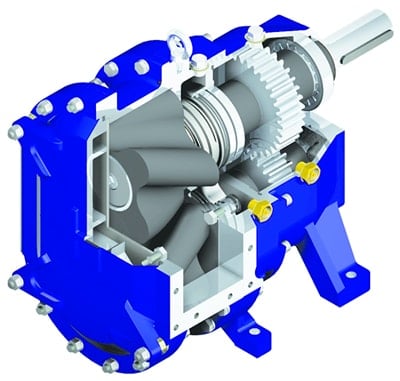Types of sewage pumps
Types of sewage pumps
Types of sewage pumps include compressed-air sewage pumps. air-flow sewage pumps, winding pumps and rotary pumps. Each of these pumps is used in specific conditions. Rotary Pumps themselves are divided into different types. The working principle of rotary pumps is based on the use of centrifugal force caused by the rotor blades. The particles of water or sewage are sent to the pump outlet and compressed by means of said blades to the guiding blades and ducts

Wastewater collection networks are now used rotary pumps except in exceptional cases at most sewage pumping stations. The advantage of these pumps is their ease of use, easier operation and greater safety. The disadvantage of these pumps is their sensitivity to suspended solids, which can be reduced by changes in the shape and number of blades. From the point of view of the shape and number of blades, depending on the type of sewage and the amount of suspended material, the following rotary pumps are used:
- One-blade radial pumps
At these pumps, the sewer enters the pump along the axis and runs out of radius. To reduce the susceptibility of the pump to suspended and coarse wastewater, the blades have been reduced to one. The pump speeds and discharges are low at about 15 to 150 liters per second and their manometry is relatively good at about 5 to 25 meters. These pumps are used to pump highly polluted wastewater that has a high amount of fiber-based waste (such as textile plant wastewater). Depending on the structure of the pump, hard and large parts as large as a few centimeters can also pass through these pumps.
- Two- or three-blade radial pumps
Increasing the number of blades in these pumps increases their discharge to about 50 to 500 liters per second and increases their susceptibility to suspended materials. Usually, the double-blade type of these pumps is mostly made. The pump’s manometer height is about 5 to 50 meters.
- Spiral Butter Pumps
These pumps can be used with open or closed blades to pump simple wastewater (eg, past the sewer network). The pumps are axial and the sewage enters the pump axis and runs at an angle of less than 23 degrees to the axis. The number of blades is usually three and a maximum of four. The manometer height is 3 to 5 meters. Used for discharges of about 500 to 1500 liters per second.
- Cylindrical pumps
These pumps have impellers that guide the distance along the axis and are sent out by the knee passing through the wall, at the pump axis passing through the knee with the help of a special sealing bowl. Take it. These pumps may be semi-axial or axial depending on the structure and speed of their particular era. These pumps are suitable for rainwater or highly diluted domestic wastewater. These pumps can supply high flow rates of about 1000 to 3500 liters per second and manometer heights of about 8 to 25 meters.
- Butterfly pumps
These pumps are types of axial-type sewage pumps in which the sewage enters the pump along the axis and runs out of the impeller along the axis. The angle of the blades of these pumps may not be constant and may change with the drill command during rotation. The impeller pumps whose blades are adjustable are called Kaplan pumps. The application of impeller pumps is suitable for rainwater or highly diluted or relatively refined domestic wastewater. These pumps can deliver high discharges of about 500 to 5000 liters per second at low manometer altitudes of about 2 to 8 meters. . The water moves along the axis with the help of blades and in the cylindrical shaft and then shifts by the knee. Both types of recent dam pumps are highly susceptible to suspended solids, especially fibers suspended, and such pumps are used only for surface sewage pumping.

